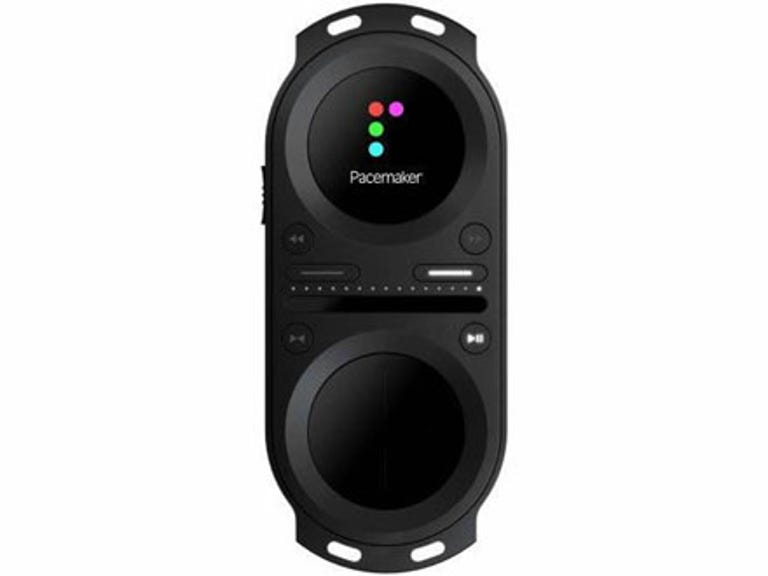 Why You Can Trust CNET
Why You Can Trust CNET Tonium Pacemaker review: Tonium Pacemaker
The Pacemaker is a pricey but addictive toy for beat mixers, and a good way to experiment with song combos without having to lug records and turntables around.
Everyone loves a DJ. Especially one of those too cool for skool DJs who wears sunglasses at night. But the downside of being a deck spinner is that you have to lug your records around from club to club. Total grind.
The Good
The Bad
The Bottom Line
Swedish company Tonium has come up with an alternative: the Pacemaker. This handheld device allows you to store, play and mix a bunch of tracks by holding down buttons and wiggling your finger over a trackpad. The notion of turning up to a house party equipped with only the Pacemaker and plugging in for a night of dance-floor madness is enough to impress, but sweeteners come in the form of the editing software and an online community where you can share the mixes you've made.
Design
The Pacemaker's utilitarian looks and hefty size make it a different beast to your average superslick MP3 player, but its no-fuss sturdiness suits the nomadic life of your average club-hopping DJ. Two equal-sized circles — one a display, the other a touchpad — take up the bulk of the Pacemaker. A touch-sensitive horizontal cross-fader cuts across the middle, with two track selector buttons above it and four multi-purpose keys at the edges.
On the left side is the slider switch that's the key to the Pacemaker's many functions. The touch pad responds differently according to whether you hold the switch up or down — for example, keeping it pushed up allows you to control audio effects, while moving it down gives access to the headphone volume.
Snuggled into a recessed section at the top of the device are a power button, USB port and a very nifty Kill All button, which will get you out of trouble if you've applied too many effects and can no longer recognise the track that's playing. On the bottom of the Pacemaker is a neat line of three ports: sockets for power, line-out, and headphones.
The Pacemaker's packaging is terribly endearing. The unit and its accessories are nestled into neat black boxes, each of which is fluoro inside. Sayings like "Listen to your mother" and "Plan for many pleasures ahead" are inscribed on the tabs of each box. It's all a bit left-field, but sets Tonium apart as a fun and irreverent company.
Features
The Pacemaker sports 120 gigabytes of storage to cram in a heap of tunes. Compatible formats include MP3, AAC, AIFF, FLAC, WAV and Ogg Vorbis, and the audio outputs can be routed to headphones, computers, mixers and speakers. As with a set of decks, you can cue tracks by listening to one channel via headphones while the other plays through the audio-out port.
Anyone with DJ leanings or a penchant for blips and bleeps will be familiar with functions like cross-fading, pitch fading and looping. These and audio effects such as hi-cut/lo-cut, roll, echo and reverb can be applied to tracks by dragging a finger in particular gestures along the circular trackpad.
Performance
Using the Pacemaker requires that you climb a pretty steep learning curve, but if you can stretch your internet-ravaged attention span long enough to read the manual and watch a few instructional YouTube videos, the rewards are many.
The fingerpad gestures for applying sound effects take a while to memorise, but the circular pad is surprisingly responsive and accurate, with no lags. Once you've got the hang of pressing the various buttons and dancing your hand across the device, you can start to record, save and upload your mixes. The bundled Pacemaker Editor software integrates nicely with the device and shows appealing attention to detail; for example, dragging the time indicator over a track results in a record-scratching noise.
The online community at Pacemaker.net is teeming with dance music fanatics to share your tracks with, which adds a community dimension to the experience.
Overall
All up, the Pacemaker is an addictive toy for beat mixers, and a good way to experiment with song combos without having to lug records and turntables around. The only problem is that the AU$1,099 price tag and slightly fiddly controls may mean it struggles to find its way into the pockets of a more mainstream crowd. If the local DJ set can handle the drop in audio richness that comes with digital — rather than vinyl-bound — audio, the Pacemaker should find a comfortable home among Australia's deck spinners.


